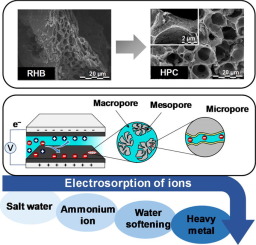Separation and Purification Technology ( IF 8.6 ) Pub Date : 2020-03-05 , DOI: 10.1016/j.seppur.2020.116813 Dinh Viet Cuong , Po-Chang Wu , Nei-Ling Liu , Chia-Hung Hou

|
Hierarchical porous carbon (HPC) as an eco-friendly electrode material was fabricated from rice husk biochar using the hard template method for electrosorption of ions. The porous structure in HPC materials can be controlled by different activation times to optimize the material physicochemical and electrochemical properties. The HPC sample achieved a high specific surface area (1839 m2 g−1), large pore volume (1.21 cm3 g−1) and 58% mesopore to total pore volume ratio. The HPC electrode exhibited excellent electrochemical properties with a high specific capacitance of 120.5 F g−1 at 5 mV s−1 in a 1 M NaCl solution as well as good reversibility for capacitive charge storage. The large ion-accessible specific surface area, interconnected pore structure among micropores and mesopores, and large mesoporosity of the HPC electrode played crucial roles in the enhancement of the electrosorption performance. The HPC electrode exhibited a high electrosorption capacity of 8.11 mg g−1 and mean deionization rate of 0.92 mg g−1 min−1 for 20 mM NaCl in single-pass capacitive deionization. The associated charge efficiency and energy consumption were 48.1% and 0.064 kWh mol−1, respectively, indicating a low energy requirement of water desalination. Furthermore, the HPC electrode showed good regeneration ability in consecutive cycles for the removal of inorganic pollutants, i.e., NH4+, Mg2+ and Cu2+, with electrosorption capacities of 1.54, 1.53 and 0.52 mg g−1, respectively. Consequently, HPC from tailored activated rice husk biochar can provide a new opportunity to achieve high-performance electrosorption in various water and wastewater treatment processes.
中文翻译:

源自活化生物炭的分层多孔碳,可作为电吸附无机离子的环保电极
采用硬模板法对离子进行电吸附,从稻壳生物炭中制备出作为生态友好型电极材料的分层多孔碳(HPC)。HPC材料中的多孔结构可以通过不同的活化时间来控制,以优化材料的物理化学和电化学性能。HPC样品实现了高比表面积(1839 m 2 g -1),大孔体积(1.21 cm 3 g -1)和58%的中孔与总孔体积比。HPC电极具有出色的电化学性能,在5 mV s -1时具有120.5 F g -1的高比电容在1 M NaCl解决方案中具有良好的可逆性,以及良好的可逆性,可用于电容性电荷存储。离子可及的比表面积大,微孔和中孔之间相互连通的孔结构以及HPC电极的大中孔性在提高电吸附性能方面起着至关重要的作用。在单程电容去离子中,对于20 mM NaCl,HPC电极表现出8.11 mg g -1的高电吸附容量和0.92 mg g -1 min -1的平均去离子速率。相关的充电效率和能量消耗为48.1%和0.064 kWh mol -1分别表明淡化水的能源需求低。此外,HPC电极在连续循环中表现出良好的再生能力,用于去除无机污染物,即NH 4 +,Mg 2+和Cu 2+,电吸附容量分别为1.54、1.53和0.52 mg g -1。因此,量身定制的活化稻壳生物炭中的HPC可为在各种水和废水处理过程中实现高性能电吸附提供新的机会。



























 京公网安备 11010802027423号
京公网安备 11010802027423号